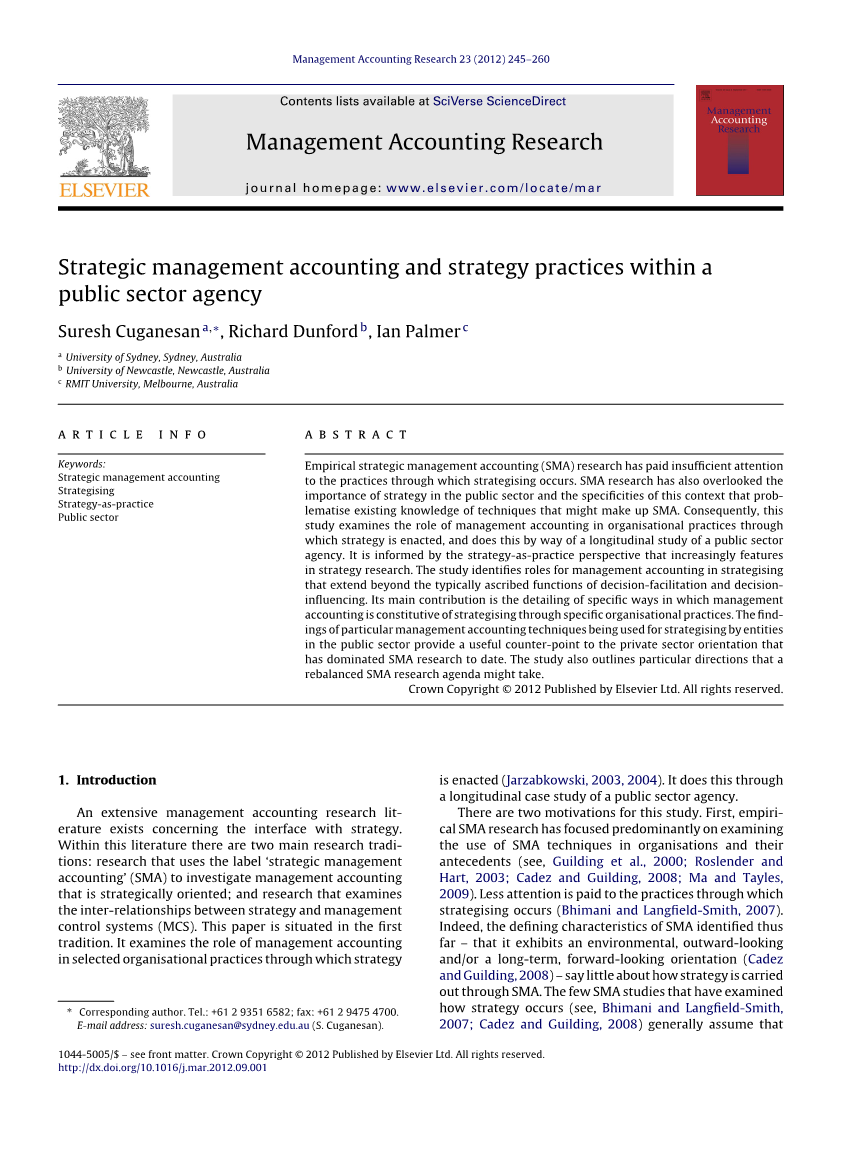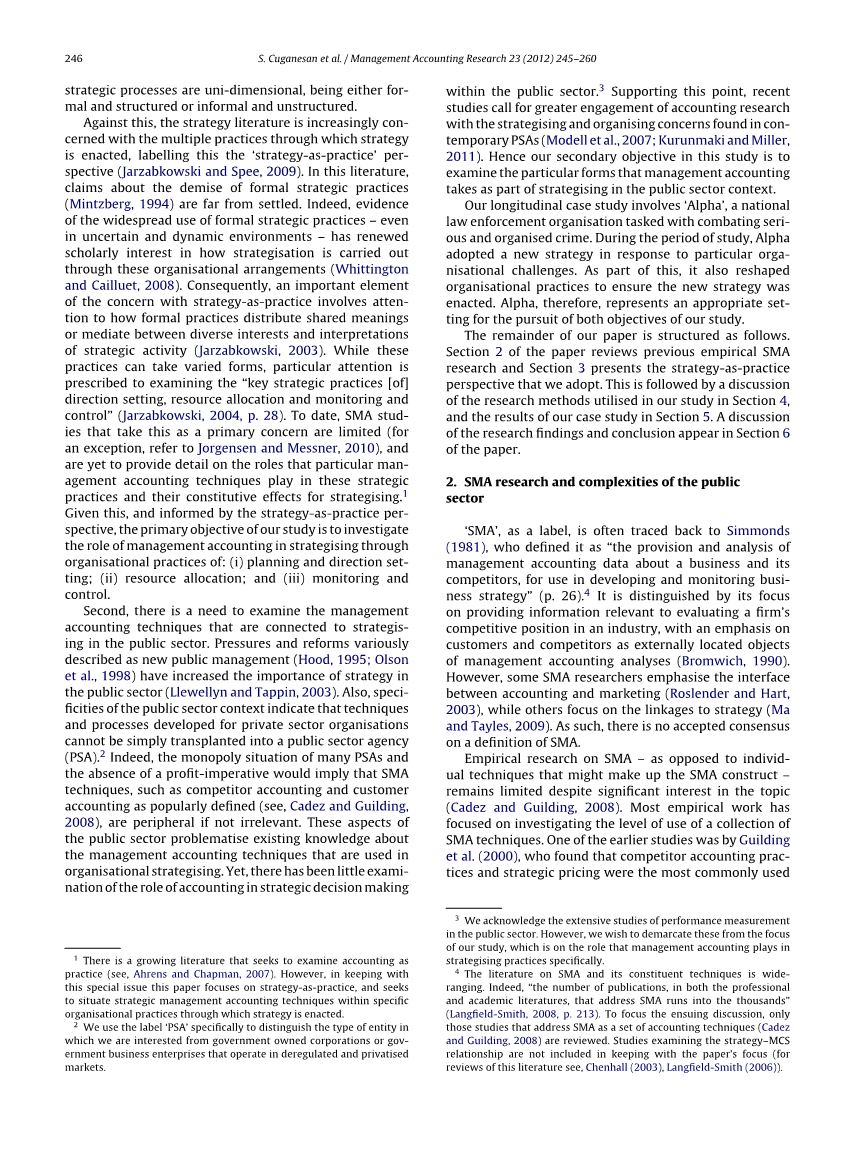

英语原文共 16 页
Strategic management accounting and strategy practices within a public sector agency
Suresh Cuganesan, Richard Dunford, Ian Palmer
Abstract
Empirical strategic management accounting (SMA) research has paid insufficient attention to the practices through which strategising occurs. SMA research has also overlooked the importance of strategy in the public sector and the specificities of this context that problematise existing knowledge of techniques that might make up SMA. Consequently, this study examines the role of management accounting in organisational practices through which strategy is enacted, and does this by way of a longitudinal study of a public sector agency. It is informed by the strategy-as-practice perspective that increasingly features in strategy research. The study identifies roles for management accounting in strategising that extend beyond the typically ascribed functions of decision-facilitation and decisioninfluencing. Its main contribution is the detailing of specific ways in which management accounting is constitutive of strategising through specific organisational practices. The findings of particular management accounting techniques being used for strategising by entities in the public sector provide a useful counter-point to the private sector orientation that has dominated SMA research to date. The study also outlines particular directions that a rebalanced SMA research agenda might take.
1.Introduction
An extensive management accounting research literature exists concerning the interface with strategy.Within this literature there are two main research traditions: research that uses the label lsquo;strategic management accountingrsquo; (SMA) to investigate management accounting that is strategically oriented; and research that examines the inter-relationships between strategy and management control systems (MCS). This paper is situated in the first tradition. It examines the role of management accounting in selected organisational practices through which strategyis enacted (Jarzabkowski, 2003, 2004). It does this through a longitudinal case study of a public sector agency.
There are two motivations for this study. First, empirical SMA research has focused predominantly on examining the use of SMA techniques in organisations and their antecedents (see, Guilding et al., 2000; Roslender and Hart, 2003; Cadez and Guilding, 2008; Ma and Tayles,
2009). Less attention is paid to the practices through which strategising occurs (Bhimani and Langfield-Smith, 2007). Indeed, the defining characteristics of SMA identified thus far-that it exhibits an environmental, outward-looking and/or a long-term, forward-looking orientation (Cadez and Guilding, 2008)-say little about how strategy is carried out through SMA. The few SMA studies that have examined how strategy occurs (see, Bhimani and Langfield-Smith,2007; Cadez and Guilding, 2008) generally assume that strategic processes are uni-dimensional, being either formal and structured or informal and unstructured.
Against this, the strategy literature is increasingly concerned with the multiple practices through which strategy is enacted, labelling this the lsquo;strategy-as-practicersquo; perspective (Jarzabkowski and Spee, 2009). In this literature,claims about the demise of formal strategic practices (Mintzberg, 1994) are far from settled. Indeed, evidence of the widespread use of formal strategic practices-even in uncertain and dynamic environments-has renewed scholarly interest in how strategisation is carried out through these organisational arrangements (Whittington and Cailluet, 2008). Consequently, an important element of the concern with strategy-as-practice involves attention to how formal practices distribute shared meanings or mediate between diverse interests and interpretations of strategic activity (Jarzabkowski, 2003). While these practices can take varied forms, particular attention is prescribed to examining the “key strategic practices [of] direction setting, resource allocation and monitoring and control” (Jarzabkowski, 2004, p. 28). To date, SMA studies that take this as a primary concern are limited (for an exception, refer to Jorgensen and Messner, 2010), and are yet to provide detail on the roles that particular management accounting techniques play in these strategic practices and their constitutive effects for strategising.1Given this, and informed by the strategy-as-practice perspective,the primary objective of our study is to investigate the role of management accounting in strategising through organisational practices of: (i) planning and direction setting; (ii) resource allocation; and (iii) monitoring and control.
Second, there is a need to examine the management accounting techniques that are connected to strategising in the public sector. Pressures and reforms variously described as new public management (Hood, 1995; Olson et al., 1998) have increased the importance of strategy in the public sector (Llewellyn and Tappin, 2003). Also, speci-ficities of the public sector context indicate that techniques and processes developed for private sector organisations cannot be simply transplanted into a public sector agency (PSA).2 Indeed, the monopoly situation of many PSAs and the absence of a profit-imperative would imply that SMA techniques, such as competitor accounting and customer accounting as popularly defined (see, Cadez and Guilding,
2008), are peripheral if not irrelevant. These aspects of the public sector problematise existing knowledge about the management accounting techniques that are used in organisational strategising. Yet,there has been little examination of the role of accounting in strategic decision making within the public sector.3 Supporting this point, recent studie
资料编号:[4491]


